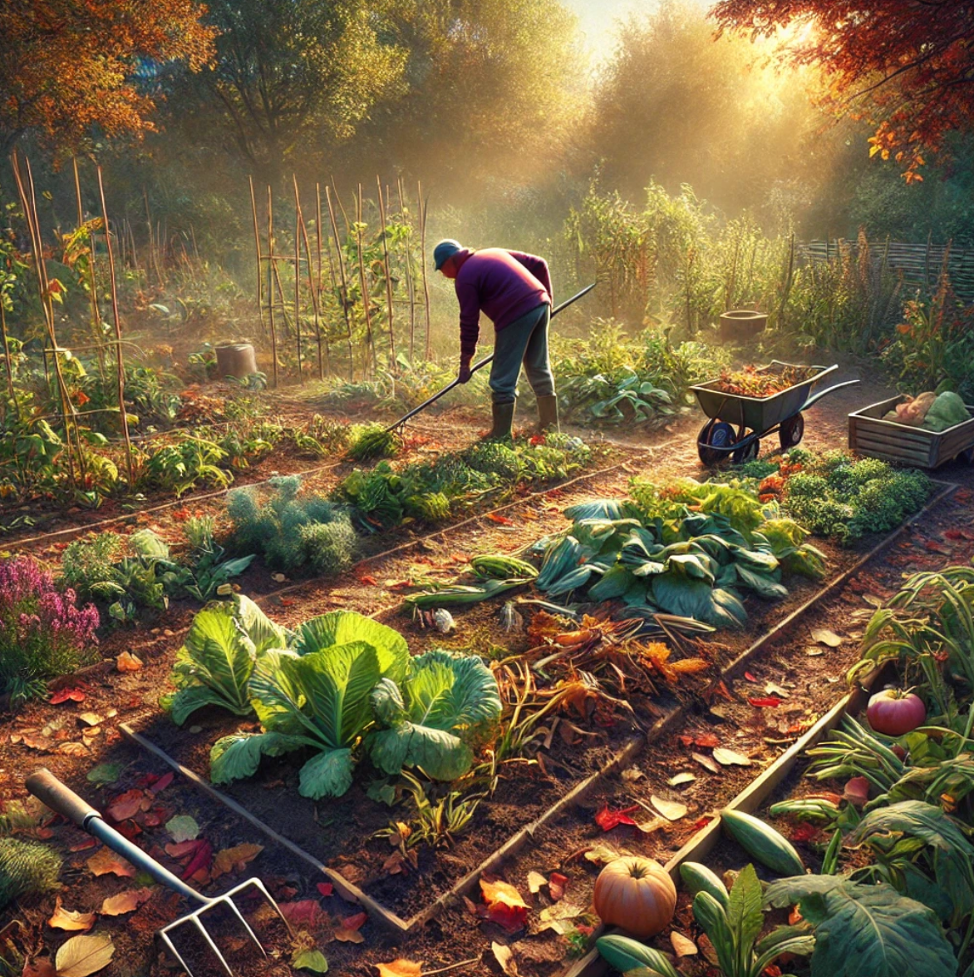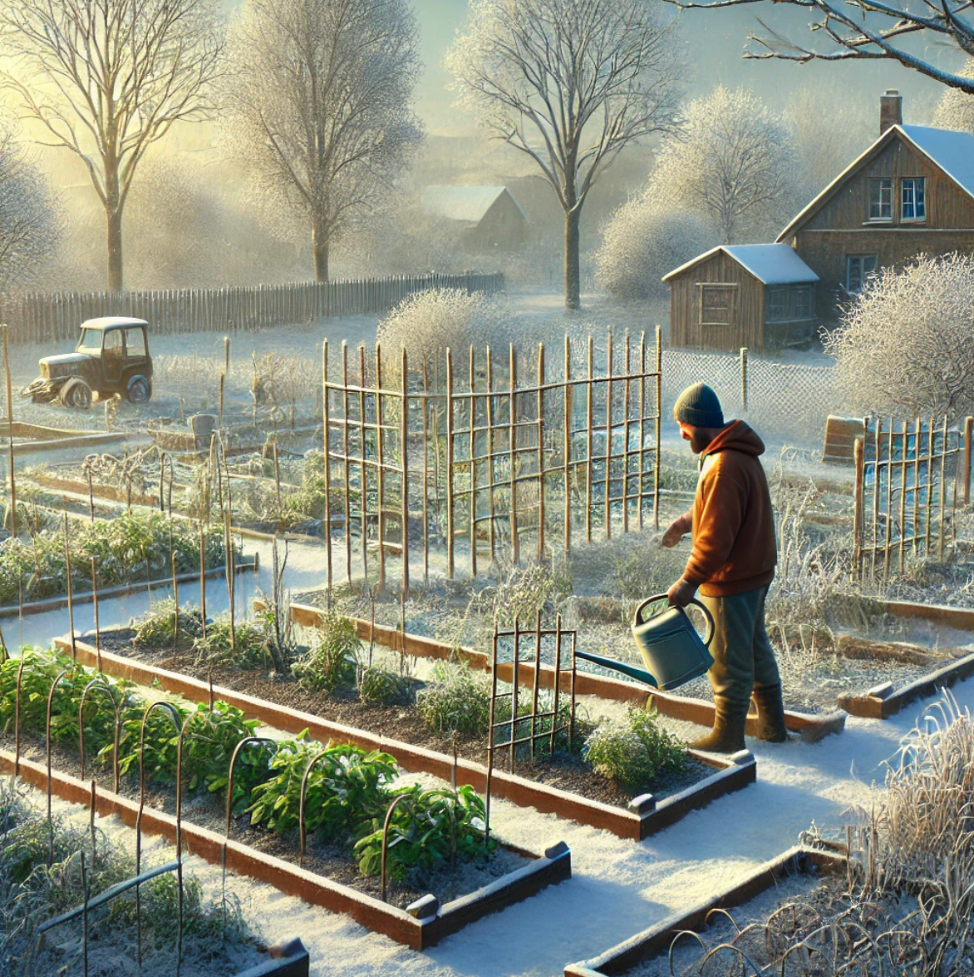As the growing season winds down and cooler temperatures set in, it’s time to start thinking about preparing your vegetable garden for the winter months. Properly winterizing your garden not only protects your soil and plants but also sets the stage for a successful and bountiful harvest next spring. This guide, tailored for gardeners across the USA, will walk you through the essential steps to prepare your vegetable garden for winter.
1. Clean Up Spent Plants and Debris

The first step in winterizing your vegetable garden is to remove any spent plants, weeds, and garden debris. Leaving old plants in the garden can harbor pests and diseases that could affect next year’s crops.
- Remove Spent Plants: Pull up and compost any dead or dying vegetable plants, making sure to discard any that were diseased to prevent the spread of pathogens.
- Clear Weeds: Remove any weeds from your garden beds to prevent them from going to seed and spreading next season.
- Collect Garden Debris: Rake up leaves, stems, and other garden debris, which can harbor insects and fungal spores if left to decompose on the soil.
2. Add Organic Matter and Amend the Soil

Improving your soil during the winter months is key to ensuring a healthy, productive vegetable garden in the spring. Adding organic matter and amendments helps improve soil structure, fertility, and drainage.
- Incorporate Compost: Spread a layer of compost over your garden beds and work it into the soil. Compost enriches the soil with nutrients and improves its texture.
- Add Manure: If you have access to well-rotted manure, this is an excellent time to add it to your garden. Manure adds essential nutrients and organic matter to the soil.
- Use Mulch: Apply a thick layer of mulch, such as straw or shredded leaves, to protect the soil from erosion and temperature fluctuations. Mulch also helps retain moisture and adds organic matter as it breaks down.
3. Plant Cover Crops for Soil Health
Cover crops, also known as green manure, are an excellent way to protect and enrich your soil over the winter. These plants help prevent soil erosion, suppress weeds, and add nutrients back into the soil.
- Choose the Right Cover Crop: Consider planting cover crops like winter rye, clover, or vetch. These crops grow during the cool season and are tilled into the soil in the spring to add organic matter and nutrients.
- Sow Cover Crops Early: Plant cover crops early enough in the fall to give them time to establish before the first frost. This ensures they will provide maximum benefit to your soil.
- Mow and Till in Spring: In the spring, mow down the cover crops before they go to seed, and till them into the soil a few weeks before planting your vegetables. This green manure will decompose, enriching the soil for your spring crops.
4. Protect Perennial Vegetables

If you grow perennial vegetables like asparagus, rhubarb, or artichokes, they need extra care to survive the winter and thrive in the spring.
- Mulch Around Perennials: Apply a thick layer of mulch around the base of perennial vegetables to insulate their roots and protect them from freezing temperatures.
- Cut Back Dead Foliage: Trim back any dead foliage on perennial vegetables to prevent disease and promote healthy growth in the spring.
- Consider Row Covers: For extra protection in particularly cold climates, consider using row covers or frost blankets over your perennial vegetables.
5. Plan for Spring
Winter is the perfect time to start planning your spring vegetable garden. Reflect on what worked well in the past season and what didn’t, and use that information to make improvements.
- Sketch Out a Garden Plan: Plan where you will plant different crops in the spring, taking crop rotation and companion planting into account to optimize your garden’s productivity.
- Order Seeds Early: Begin browsing seed catalogs and order your seeds early to ensure you get the varieties you want before they sell out.
- Prepare New Beds: If you plan to expand your vegetable garden, start preparing new beds during the fall and winter. Remove any grass or weeds, amend the soil, and cover the beds with mulch to keep them weed-free until spring.
6. Winter Watering and Maintenance

While your vegetable garden might not need as much attention during the winter, it’s important to keep an eye on it and perform occasional maintenance to ensure everything is in good shape.
- Check Soil Moisture: If you live in a dry winter climate, make sure to check the soil moisture and water your garden as needed. Plants and soil still need moisture to stay healthy during the winter.
- Inspect Garden Structures: Regularly check on any garden structures like trellises, raised beds, or cold frames to ensure they are intact and ready for spring use.
- Monitor for Pests: Keep an eye out for any signs of pests that might be overwintering in your garden, and take action to remove them if necessary.
Conclusion
Preparing your vegetable garden for winter is an essential part of ensuring a healthy and productive growing season next year. By cleaning up your garden, improving your soil, planting cover crops, protecting perennials, and planning for spring, you’ll set the stage for a bountiful harvest. Follow these tips to keep your garden in top shape through the winter and ready to burst into life when the warm weather returns.

